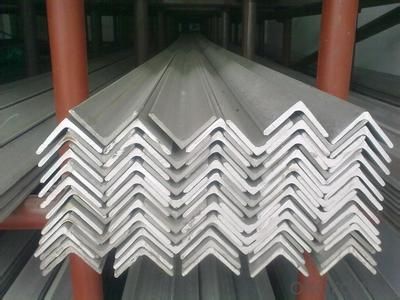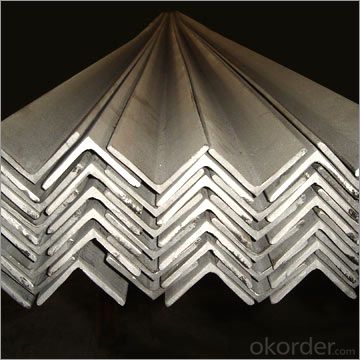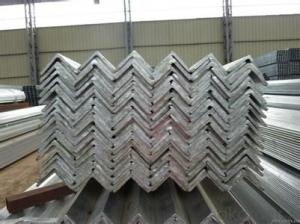Angle Steel Hot Rolled High Quality ASTM A36 25-250MM
- Loading Port:
- Tianjin
- Payment Terms:
- TT OR LC
- Min Order Qty:
- 25 m.t.
- Supply Capability:
- 20000000 m.t./month
OKorder Service Pledge
OKorder Financial Service
You Might Also Like
Item specifice
Product Description:
OKorder is offering Angle Steel Hot Rolled High Quality ASTM A36 25-250MM at great prices with worldwide shipping. Our supplier is a world-class manufacturer of steel, with our products utilized the world over.
Product Applications:
According to the needs of different structures, Angle can compose to different force support component, bridges, transmission towers, hoisting machinery and transport machinery, ships, industrial furnaces, reaction tower, container frame and warehouse etc
Product Advantages:
OKorder's Angle Steel Hot Rolled High Quality ASTM A36 25-250MM are durable, strong, and resist corrosion.
Main Product Features:
· Premium quality
· Prompt delivery & seaworthy packing (30 days after receiving deposit)
· Corrosion resistance
· Can be recycled and reused
· Mill test certification
· Professional Service
· Competitive pricing
Product Specifications:
Manufacture: Hot rolled
Grade: Q195 – 235
Certificates: ISO, SGS, BV, CIQ
Length: 6m – 12m, as per customer request
Packaging: Export packing, nude packing, bundled
Sizes: 25mm-250mm | ||||||||||||
a*t | ||||||||||||
25*2.5-4.0 | 70*6.0-9.0 | 130*9.0-15 | ||||||||||
30*2.5-6.6 | 75*6.0-9.0 | 140*10-14 | ||||||||||
36*3.0-5.0 | 80*5.0-10 | 150*10-20 | ||||||||||
38*2.3-6.0 | 90*7.0-10 | 160*10-16 | ||||||||||
40*3.0-5.0 | 100*6.0-12 | 175*12-15 | ||||||||||
45*4.0-6.0 | 110*8.0-10 | 180*12-18 | ||||||||||
50*4.0-6.0 | 120*6.0-15 | 200*14-25 | ||||||||||
60*4.0-8.0 | 125*8.0-14 | 250*25 | ||||||||||
FAQ:
Q1: Why buy Materials & Equipment from OKorder.com?
A1: All products offered byOKorder.com are carefully selected from China's most reliable manufacturing enterprises. Through its ISO certifications, OKorder.com adheres to the highest standards and a commitment to supply chain safety and customer satisfaction.
Q2: How do we guarantee the quality of our products?
A2: We have established an advanced quality management system which conducts strict quality tests at every step, from raw materials to the final product. At the same time, we provide extensive follow-up service assurances as required.
Q3: How soon can we receive the product after purchase?
A3: Within three days of placing an order, we will begin production. The specific shipping date is dependent upon international and government factors, but is typically 7 to 10 workdays.



- Q:What is the maximum length for a steel angle bracket?
- The length of a steel angle bracket can differ based on the manufacturer and design. Typically, these brackets come in lengths ranging from 1 inch to 8 feet or greater. It should be noted that longer brackets may be susceptible to bending or flexing when subjected to heavy loads. Therefore, it is crucial to consider the intended use and weight-bearing specifications when choosing the suitable length for a steel angle bracket. Moreover, it is advisable to consult the manufacturer's guidelines and specifications to guarantee that the maximum length of the bracket is not surpassed, as this could jeopardize its structural integrity.
- Q:How do you calculate the bending capacity of a steel angle?
- In order to determine the bending capacity of a steel angle, several factors must be considered. The initial step involves calculating the moment of inertia (I) of the angle section, which measures its resistance to bending. The moment of inertia relies on the angle's shape and dimensions, and can be found in the manufacturer's specifications or through calculations. Once the moment of inertia has been obtained, the section modulus (Z) can be calculated as another indicator of the section's ability to resist bending. The section modulus is found by dividing the moment of inertia by the distance from the centroid of the section to the extreme fiber. Subsequently, it is necessary to establish the maximum allowable bending stress (σ) for the steel angle. This value is typically provided by the manufacturer or can be determined based on the desired safety factor and the type of steel being used. Lastly, the bending capacity (M) of the steel angle can be calculated by utilizing the formula M = σ * Z. This calculation provides the maximum moment that the angle can endure without experiencing excessive bending stress. It is important to note that these calculations assume the angle's behavior is elastic and do not account for additional factors such as local buckling, residual stresses, or combined loading. Therefore, it is advisable to consult relevant design codes or guidelines for a more comprehensive analysis to ensure the safety and reliability of the steel angle in a specific application.
- Q:Can steel angles be used in electrical or telecommunications installations?
- Yes, steel angles can be used in electrical or telecommunications installations. Steel angles are commonly used as structural supports and mounting brackets in these types of installations due to their strength, durability, and versatility.
- Q:Can steel angles be painted over?
- Yes, steel angles can be painted over. Prior to painting, it is important to clean and prepare the surface by removing any rust, dirt, or grease. Applying a primer will help improve adhesion and longevity of the paint. Once the primer is dry, a suitable paint can be applied to achieve the desired finish and protect the steel angles from corrosion.
- Q:How are steel angles cut to specific lengths?
- To achieve specific lengths, various cutting tools and techniques are employed for steel angles. Among these, a common approach involves the use of saws, such as band saws or circular saws with metal-cutting blades. By securely clamping or holding the angle in place, a precise and clean cut can be made as the saw blade is guided along the desired cutting line. Alternatively, an abrasive cutting wheel, also known as a cutoff wheel or grinding disc, can be utilized. This method is particularly suitable for thinner steel angles or situations requiring a more accurate cut. By securing the angle in a vise or similar holding device, the cutting wheel is cautiously guided along the marked cutting line, removing excess material. For larger and thicker steel angles, plasma cutters or oxy-fuel torches are viable options. Both methods involve elevating the steel's temperature to a point where it either melts or oxidizes, enabling a meticulous and precise cut. Plasma cutters utilize a focused jet of ionized gas, while oxy-fuel torches employ a combination of oxygen and a fuel gas, like acetylene or propane. In certain cases, more specialized techniques such as water jet cutting or laser cutting can be utilized to cut steel angles. Water jet cutting employs a high-pressure stream of water mixed with abrasive particles to erode the steel, while laser cutting relies on a concentrated laser beam to melt or vaporize the material along the intended cutting path. Regardless of the chosen method, it is crucial to firmly secure the angle in place and accurately guide the cutting tool along the marked cutting line. When cutting steel angles to specific lengths, it is important to prioritize safety by taking appropriate precautions like wearing protective eyewear and gloves.
- Q:What are the common welding techniques for steel angles?
- The common welding techniques for steel angles include shielded metal arc welding (SMAW), gas metal arc welding (GMAW), and flux-cored arc welding (FCAW).
- Q:What are the different types of steel angles used in staircases?
- There are mainly two types of steel angles used in staircases: the L-shaped angle and the T-shaped angle. The L-shaped angle is commonly used for the construction of the stair stringers, while the T-shaped angle is typically utilized for the treads and risers.
- Q:How do steel angles perform in chemical industry applications?
- Steel angles are commonly used in chemical industry applications due to their excellent strength, durability, and corrosion resistance. They can withstand harsh chemical environments, making them ideal for supporting structures, platforms, and equipment in chemical plants. Additionally, steel angles can be easily welded, providing flexibility in design and construction.
- Q:What are the different types of steel angles used in shipbuilding?
- In shipbuilding, there are several types of steel angles that are commonly used for various structural purposes. These angles are typically made from high-strength steel and are designed to provide strength and stability to the ship's structure. Here are some of the different types of steel angles used in shipbuilding: 1. Bulb Angles: These angles are specifically designed for use in the construction of ship hulls. They have a bulbous shape on one side, which helps in distributing the load and providing additional strength and stability to the hull structure. 2. L-Shaped Angles: L-shaped angles, also known as unequal angles, are widely used in shipbuilding for framing and bracing purposes. These angles have one leg longer than the other, allowing them to be used in various applications where different lengths are required. 3. Equal Angles: Equal angles, also known as L-sections, have two legs of equal length and are commonly used in shipbuilding for framing and supporting structures. They provide uniform strength and can be used in a variety of applications, including bulkhead framing and deck support. 4. Flat Bars: Although not technically angles, flat bars are often used in shipbuilding for similar purposes. These bars have a rectangular cross-section and are typically used for reinforcement, framing, and connecting various structural components. 5. T-Sections: T-sections, also known as T-angles, have a T-shaped cross-section and are commonly used in shipbuilding for structural framing, reinforcement, and connecting different components. The vertical leg of the T-section provides additional strength and stability to the structure. 6. Z-Sections: Z-sections, also known as Z-angles, have a Z-shaped cross-section and are used in shipbuilding for various purposes, such as framing, bracing, and supporting structures. These angles offer excellent load-bearing capacity and are often used in applications where maximum strength is required. Overall, the choice of steel angles in shipbuilding depends on the specific requirements of the structure, including the load-bearing capacity, structural design, and intended use. The aforementioned types of steel angles provide a wide range of options to meet the diverse needs of ship construction.
- Q:How are steel angles made?
- Steel angles are made through a process called hot rolling, where steel billets are heated and passed through a series of rollers to give them their desired shape and dimensions.
1. Manufacturer Overview |
|
|---|---|
| Location | |
| Year Established | |
| Annual Output Value | |
| Main Markets | |
| Company Certifications | |
2. Manufacturer Certificates |
|
|---|---|
| a) Certification Name | |
| Range | |
| Reference | |
| Validity Period | |
3. Manufacturer Capability |
|
|---|---|
| a)Trade Capacity | |
| Nearest Port | |
| Export Percentage | |
| No.of Employees in Trade Department | |
| Language Spoken: | |
| b)Factory Information | |
| Factory Size: | |
| No. of Production Lines | |
| Contract Manufacturing | |
| Product Price Range | |
Send your message to us
Angle Steel Hot Rolled High Quality ASTM A36 25-250MM
- Loading Port:
- Tianjin
- Payment Terms:
- TT OR LC
- Min Order Qty:
- 25 m.t.
- Supply Capability:
- 20000000 m.t./month
OKorder Service Pledge
OKorder Financial Service
Similar products
New products
Hot products
Related keywords



























